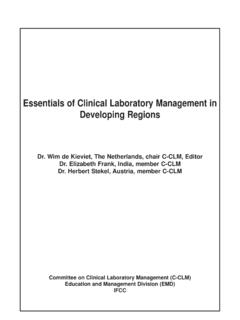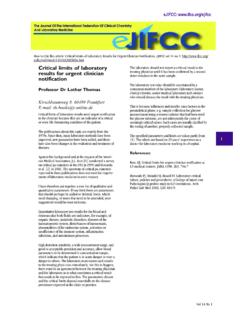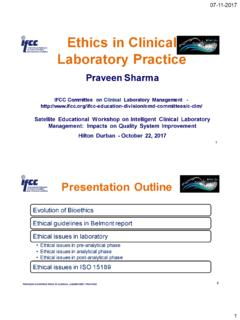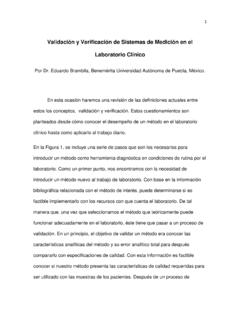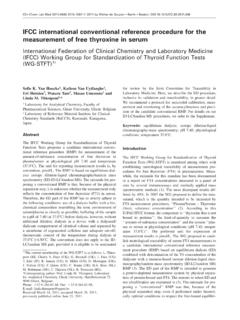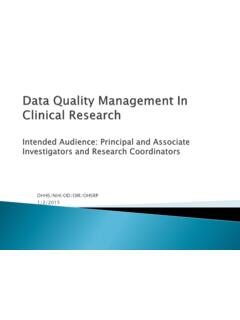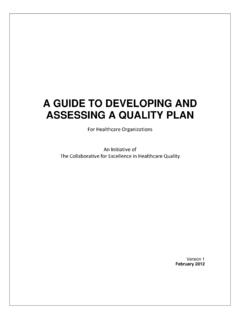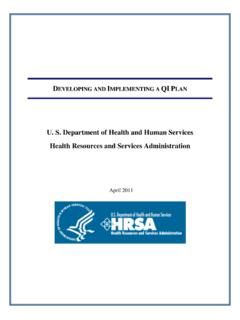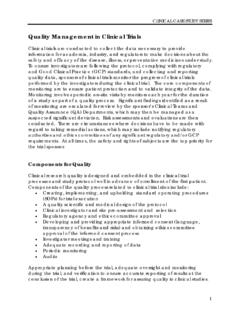Transcription of The Principles of External Quality Assurance - IFCC
1 The Principles of External Quality Assurance IFCC Committee on Analytical Quality What is Quality Assurance ? = External Quality Assurance (EQA). = External Quality assessment (EQA). = proficiency testing scheme System designed to objectively assess the Quality of results obtained by laboratories, by means of an External agency. Monitoring the Quality of Lab Results Laboratory Quality Management System eg ISO 15189. Quality Policy Quality Assurance All measures taken to assure Quality Other aspects of good Quality Control laboratory practice Internal Quality External Quality Control Assurance Indicators of Laboratory Quality Internal Quality control External Quality Assurance IQC vs EQA.
2 Internal Quality Control External Quality Assurance Results Known Unknown Results Available Immediately Later, when report received Frequency of Minimum daily, Periodically Testing per batch, eg 1 / 4weeks per shift 2 / 4 weeks 5 x 3 / year Concentrations Normal, abnormal Multiple concentrations, eg 6-8. Assess Imprecision Accuracy & imprecision Comparison Your lab only Your lab to all labs & other labs using your method ISO 15189: Medical Laboratories The laboratory shall participate in organised interlaboratory comparisons, such as External Quality assessment schemes, that encompass the extent and complexity of examination procedures used by the laboratory.
3 The laboratory management shall monitor the results of External Quality assessment and participate in the implementation of corrective actions when control criteria are not fulfilled. Interlaboratory comparison programs shall be in substantial agreement with ISO Guide 43. General Cycle of EQAS. Corrective EQA. action samples taken if received required Lab analyses EQA report EQA reviewed samples Results sent to EQA report EQA received organiser Objectives of EQA. Provide a measure for individual laboratory Quality To supplement internal Quality control procedures Provide a measure of the state of the art for a test To obtain consensus values when true values are unknown To investigate factors in performance (methods, staff etc).
4 To act as an educational stimulus to improvement in performance IFCC 1977. What to Look for in an EQA? sample design & frequency analytical goals easy to read reports scientific validity and reliability education scientific support Sample Design Appropriate matrix Stable, homogeneous material Appropriate concentration levels Appropriate frequency of testing Sample Matrix Frozen human serum ideal very expensive difficult to obtain different concentration levels unstable storing and transport very expensive danger of contamination Sample Matrix Lyophilized human serum more similar to patient specimens good long term stability very easy to transport expensive reconstitution errors denaturation of proteins/lipoproteins Stabilized liquid serum ready to use.
5 Easy to prepare great matrix effects less long term stability Appropriate Concentration Levels Range of concentration levels Not just around the reference interval Cover the analytical range of methods What to Look for in an EQA? Analytical Goals 1. Method classification system 2. Central value 3. Acceptable range Method Classification System Should fully describe your method analytical principle instrument reagent calibrator / standardisation Analytical Goals 2. Central Value What is the right' value? What is the true' value? What is the correct' value?
6 Analytical Goals 2. Central Value Target value correct value EQA material assayed by: reference methods eg IFCC enzymes, HbA1c reference laboratory higher order methods eg mass spectrometry secondary reference calibrators RCPAQAP Interim Report Analytical Goals 2. Central Value Statistical overall mean, median instrument mean both show the state of art' but give no indication of the correct value External Quality Assurance Programs Use Quality standards to allow labs to assess their performance and respond accordingly the Quality standard is the allowable difference from a target A tool for review of QAP results Can be based on statistical comparison expert opinion clinical need Analytical Goals 3.
7 Acceptable Range The analytical range around the central value A tool for review of EQA results It provides a simple tool to allow a rapid, standardised assessment of EQA results in both numerical and graphical report formats. A result outside the acceptable range should alert the laboratory that that their assay may produce results that are at risk of detrimentally affecting clinical decision making. Analytical Goals 3. Acceptable Range Can be based on statistical comparison regulatory requirements clinical need expert opinion other criteria It is important for the lab to understand how the EQA acceptable ranges are set so that they can properly interpret their EQA report Using Statistical Comparison Mean 2 SD = 95% returned results are acceptable This gives information on whether your result is acceptable compared with all results and your method But does it give information on whether your result is acceptable compared to the true' patient
8 Result? Would your result alter the clinical management of the patient? Clinical Need What amount of analytical variability (imprecision &/or bias) added to the true'. test variability (biological) is acceptable so that the patient can still have good clinical management? Biological = biological variation Biological Variation The diverse manifestations of normal' that exist between people The variation in a parameter due to physiological differences within individuals and between individuals Each individual has random fluctuations around a homeostatic set point These homeostatic set points will vary between individuals The Effect of Analytical Variability CVa = CVb 7.
9 6. RESULT. 5. 4. 3. 0 1 2 3 4 5 6 7. TIME. * Dr Ken Sikaris The Effect of Analytical Variability CVa = CVb 7. 6. RESULT. 5. 4. 3. 0 1 2 3 4 5 6 7. TIME. * Dr Ken Sikaris The Effect of Analytical Variability CVa = CVb 7. 6. RESULT. 5. 4. 3. 0 1 2 3 4 5 6 7. TIME. * Dr Ken Sikaris Stockholm Hierarchy 1. Studies on clinical outcomes 2. Clinical decisions in general, data from: biological variation clinicians' opinions 3. Published professional recommendations 4. Performance goals set by regulatory bodies or organisers of External Quality Assessment Schemes.
10 5. Goals based on the current state of the art as demonstrated by data from EQA or published method papers Acceptable Ranges It is important for the lab to understand how the EQA acceptable ranges are set so that they can properly interpret their EQA report EQA Reports What to Look for in EQA Reports What is the turn around time? how long after the due date will you receive your report? the earlier the better can remember what was happening in the lab can take corrective action sooner Is the report electronic or paper? what suits me best?
